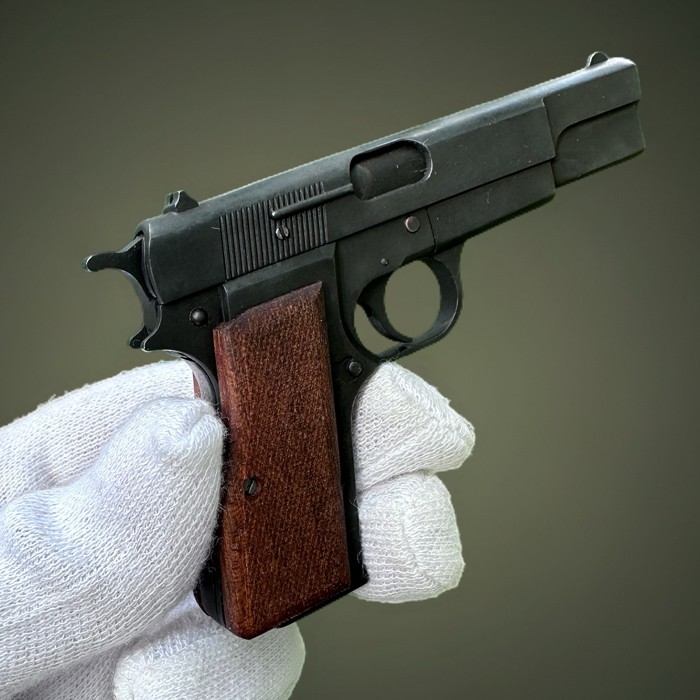Fully Functional Miniature Weapon Models Crafted with Exceptional Quality and a Lifetime Service Guarantee
Browning Hi-Power: The Craft and History of an Iconic Collectible Miniature Pistol
Table of Contents
The most popular weapons among miniature collectors are historical models that are no longer in production but are well-known in books and films, making them highly desirable for collectors. The Browning pistols, named after their creator, John Browning, are particularly sought after. John Browning revolutionized firearms in the 19th century with innovative designs such as short recoil operation, blowback system, and gas operation, which are still used today.
Browning pistols have been in mass production since the early 20th century and are renowned for their compact size and portability. They have been replicated and imitated and greatly influenced the design of subsequent automatic pistols. The Belgian firm Fabrique Nationale d’Armes de Guerre (FN) was the first and largest manufacturer of Browning pistols in Europe, leading to the common term “Belgian Browning.” Browning pistols designed for the American company Colt are typically called “Colts.”
Although John Browning also worked on automatic, smooth-bore machine guns, he is most associated with small self-loading pistols. His work on self-loading pistols began in 1895, and by 1897, he had patented his invention and started production in 1898. The initial model, known as Browning 1899, was later improved and rebranded as Browning 1900 after the first three thousand units were released.
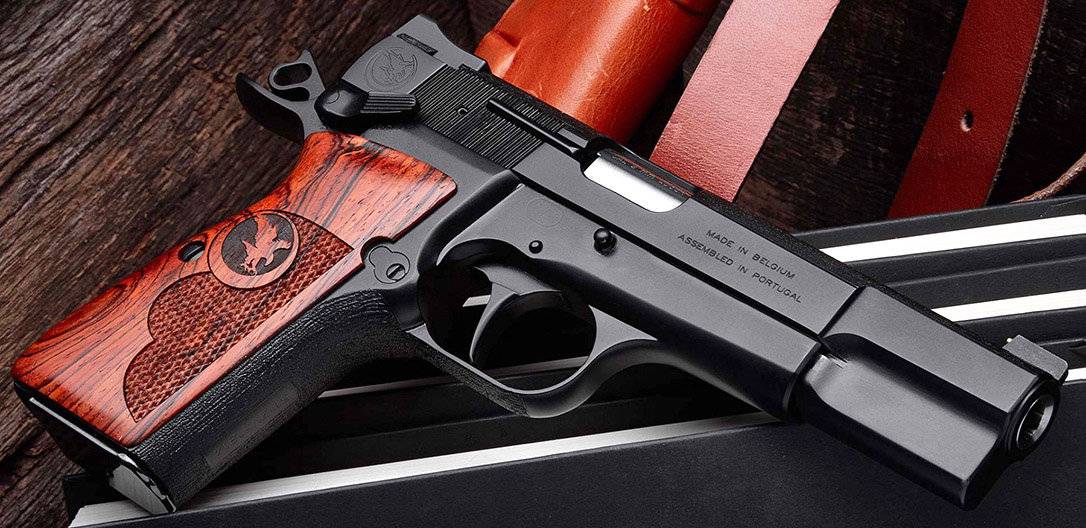
Inventing the Gun
The development of this pistol, which became very popular later, began in the early 1920s.
The initiator of this work was again the Belgian FN, acting this time on the initiative of the French military: they were interested in obtaining a combat pistol with a magazine containing 15 cartridges.
But Browning himself believed that a two-row high-capacity magazine would not be reliable, and the principal designer of the FN, Dieudonne Saive, began constructing this part of the pistol. Based on magazines created by Saive, Browning developed two pistols that differed in the locking design, and in 1923, he applied for a patent. This patent was issued only in February 1927, a few months after the designer’s death. Pistols developed in 1922, despite the promise, but were not adopted by the French army, and their improvement began to conduct Dieudonne Saive. In 1923 he replaced a hammer cock, putting a trigger cock mechanism instead, to the requirements of French military experts.
By 1927, Saive had done several works to improve the gun, reducing the store capacity to 13 rounds and shortening the shutter-casing. In 1929, the shape of the rear part of the handle was changed, and in 1931, the pistol became what we know it to be now. French experts considered this firearm quite successful and consistent with all of their requirements, but their government adopted a model created in France for the French army.
However, the SACM Mle 1935A was inferior to Browning. It concerned both the capacity of the store, which was only 8 cartridges and the capacity of the ammunition, as the 7.65 mm French Longue (7.65 × 20) can’t be compared with the 9 mm Parabellum in penetrating and stopping power of their bullets. By 1934, works for serial production of the gun were carried out.
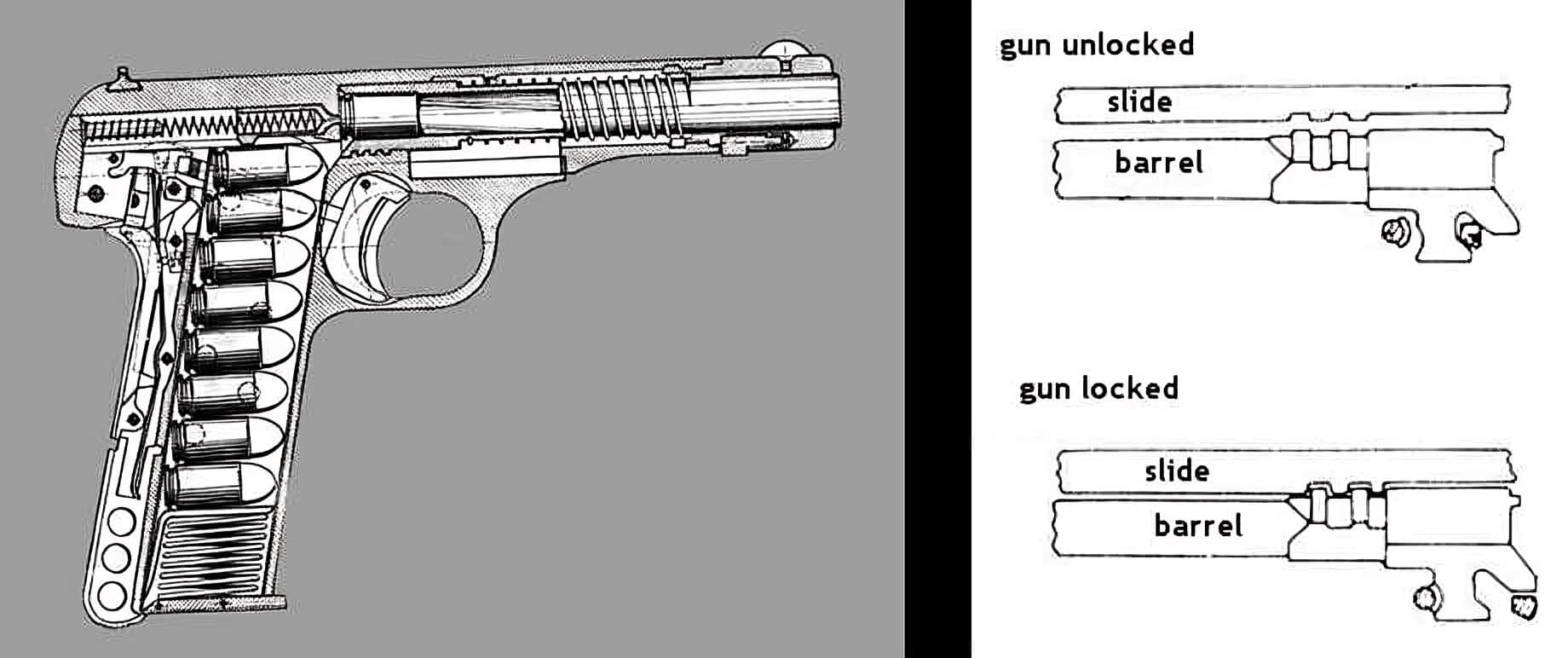
Pistol’s Milestones
In 1935, the Belgian army adopted the gun “Pistolet Automatique Browning FN Modele 1935 de Grande Puissance,” the company received the first order for 1000 copies.
But then it got a much shorter name: “GP-35”. The name “Grande Puissance,” which means “Great power,” was given, of course, for promotional purposes, but the pistol really had excellent combat qualities, and at that time, it was unsurpassed. The handgun was produced in two versions. One with vertical grooves on the back surface of the handle for fastening a holster-butt and adjustable sector sight, designed for shooting up to 500 m. The other was equipped with simple sighting devices and did not have grooves on the handle.
Then, a few more European countries began to buy it for their armed forces. Since 1935, the pistol, known worldwide as Browning High Power, has been in service in Belgium, Denmark, the Netherlands, Holland, Romania, Lithuania, Latvia, Estonia, Peru and Israel.
During World War II, HP was used in the German Wehrmacht under the designation “Pistole 640 (b)” as a limited standard weapon. From 1939 to 1945, about 319,000 such pistols were manufactured.
High-power guns manufactured in Canada were initially supplied to China. Then, the company John Inglise started manufacturing them to meet the needs of its own army, as well as the armies of Great Britain and Australia. Canadian Brownings differed in the shape of the sighting device and had four cuts in the barrel channel instead of six. This weapon is still in the arsenal of the Canadian army. Browning pistols got the designation Mk I in the British and Canadian troops.
These pistols were improved: the reliability of cartridge sleeve extraction was increased by placing the ejector inside the shutter-casing. Such weapons got the designations №1 Mk I* and №2 Mk I*. In 1946, the production of High Power was resumed at FN.
The gun was officially adopted by Britain in 1954, and then, in 1962, it was replaced with its improved version №2 MK1 or L9 A1. FN Browning High Power was used by the famous British CAC (Special Aircraft Service) from the Second World War to the present, and it is also in service to the Royal Marine Corps Fleet’s Defense Group.
HP is a permanent pistol of SBS (Special Boat Service — the unit of special forces of the Royal Marines of Great Britain). It should also be noted that after the end of World War II, the pistol with a regulated sight device was produced as a High Power Captain for the civilian arms market. Beautiful examples of this version are engraved, with gold inserts and blue bluing.
In the 1982 MK II modification, the pistol got an elongated fuse lever, which was more convenient for manipulation. In addition, the fuse became two-sided since another lever was placed on the right side of the frame. This modification is also characterized by more ergonomic plastic cheeks on the handle and a small protrusion on the front surface of the shutter-casing, designed to protect the muzzle.
Another essential feature of the MK II was the possibility of an uninterrupted supply of cartridges with expansive bullets that differ from traditional military ones with more complex configurations of their front part. In the mid-1990s, FN started the production of high-power pistols for the .40 S&W cartridge. This version was intended primarily for the civilian firearms market in the United States.
For decades of service and combat use in the most challenging conditions, the weapon proved its worth. This superb pistol was used by armies of about 55 countries, and it is one of the most common combat handguns in the world. The main characteristics of this weapon are an original locking system of the barrel with a short stroke, a two-row magazine that contains 13 cartridges, and the use of very efficient 9mm Parabellum cartridges. Combining these qualities with the convenient handle shape made this high-power gun reliable under challenging conditions.
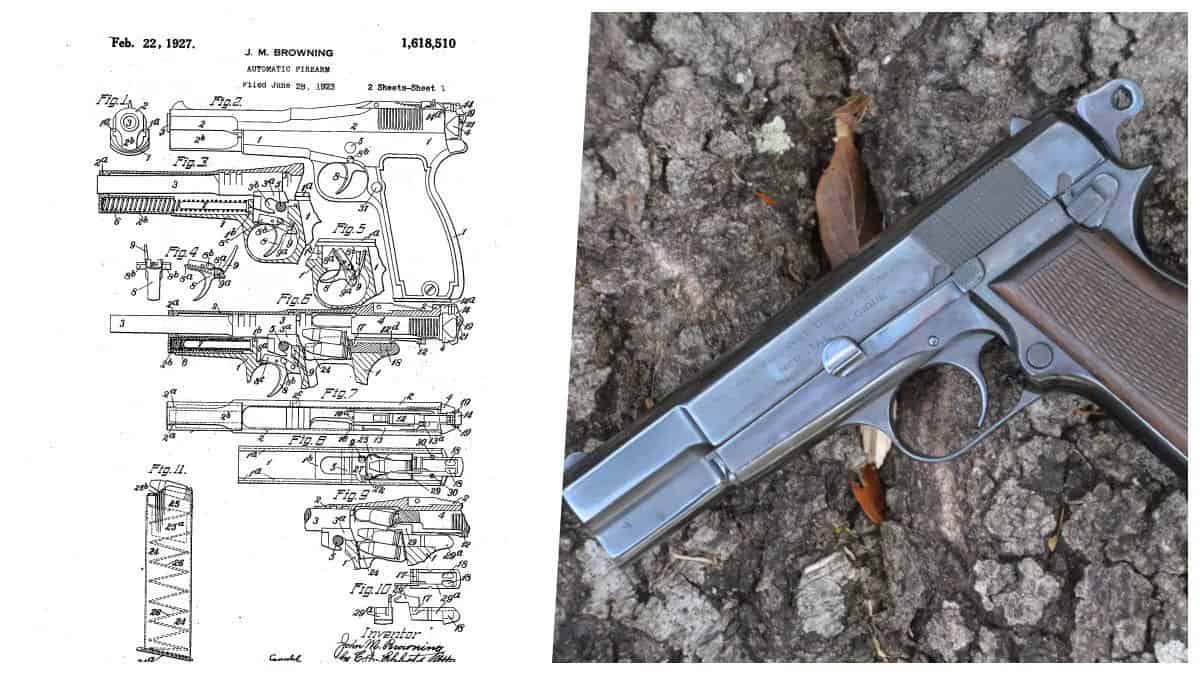
How Browning Works?
The automation of the Browning High Power firearm is a testament to precision engineering, operating on the principle of utilizing the recoil of a short-stroke barrel.
Browning’s breechblock is performed according to the scheme with a falling block, using a figure groove under the chamber. When the barrel is retracted due to the impact of recoil, this groove interacts with the axis of the barrel retention. As a result, the breech part of the barrel falls.
At this time, the barrel ledges come out of their engagement with the grooves of the shutter-casing, the barrel stops, and the shutter-casing continues to move back, throwing out the empty cartridge sleeve. Browning has a single-action trigger mechanism.
After consuming all the cartridges in the magazine, the feeder presses on the shutter delay, which rises and enters the corresponding groove of the shutter casing. As a result, the shutter-casing is fixed in the rear position and signals about the need for recharging. After attaching a loaded magazine, press the shutter delay lever down and release the shutter-casing; thus, you will send the cartridge into the chamber.
A manually operated fuse blocks the sear and the shutter-casing; its lever is located on the left side of the frame in front of the back part of the handle. The gun is equipped with a detail that does not allow making a shot when the shutter is not fully closed. The automatic magazine fuse blocks the trigger when the magazine is removed. The earliest version had an ejector located in the inner bore of the shutter-casing.
In 1965, the pistol had an open ejector, which simplified production and reduced its cost, and the trigger had a spoke instead of a massive head. The magazine with a two-row arrangement of cartridges has a single-row output, which allows the cartridge to enter the chamber in a straight line, increasing the supply’s reliability. The magazine is fastened with a latch placed in the base of the trigger clamp. The pistol handle has excellent ergonomics, providing a deep, tight grip, stabilizing the weapon when aiming, and improving firing stability.
The Browning High Power is a testament to reliability, making it an almost ideal gun for the army. It utilizes the world’s most common and powerful pistol cartridge, a capacious store, and a reliable single-action trigger mechanism. Its long-term use in the troops and law enforcement structures around the world, coupled with extensive combat experience, attests to its excellent combat and service-operational qualities.
The Browning High Power’s main advantages are its high reliability of operation in extreme conditions, high stopping power of the cartridge, simplicity, convenience, and safety of handling the gun, simplicity of care of the weapon, shooting accuracy, and high firepower. Some owners even report their HP making about 30,000 shots without delay using cartridges with full metal jacket bullets, further reinforcing its reliability.
FN High Power is very popular among servicemen, policemen, and ordinary citizens who purchase firearms for self-defense or sports shooting. HP is often modified by various firms to meet specific requirements. For example, we can mention the Novak Delux Custom BHP gun. In general, improvements are made for practical shooting.
Producers install adjustable aiming devices with luminous inserts, more convenient increased fuse lever and shutter delay levers, and various shaped handle cheeks with different textures. On the front lateral surfaces of a shutter casing, an additional notch is sometimes made for more convenient operation and faster cartridge dispatch from the magazine to the chamber.
Browning High Power is still in demand in standard models and with various improvements. Considering its numerous advantages, we can suppose that it will be very popular worldwide for a long time.
Miniature Browning Guns
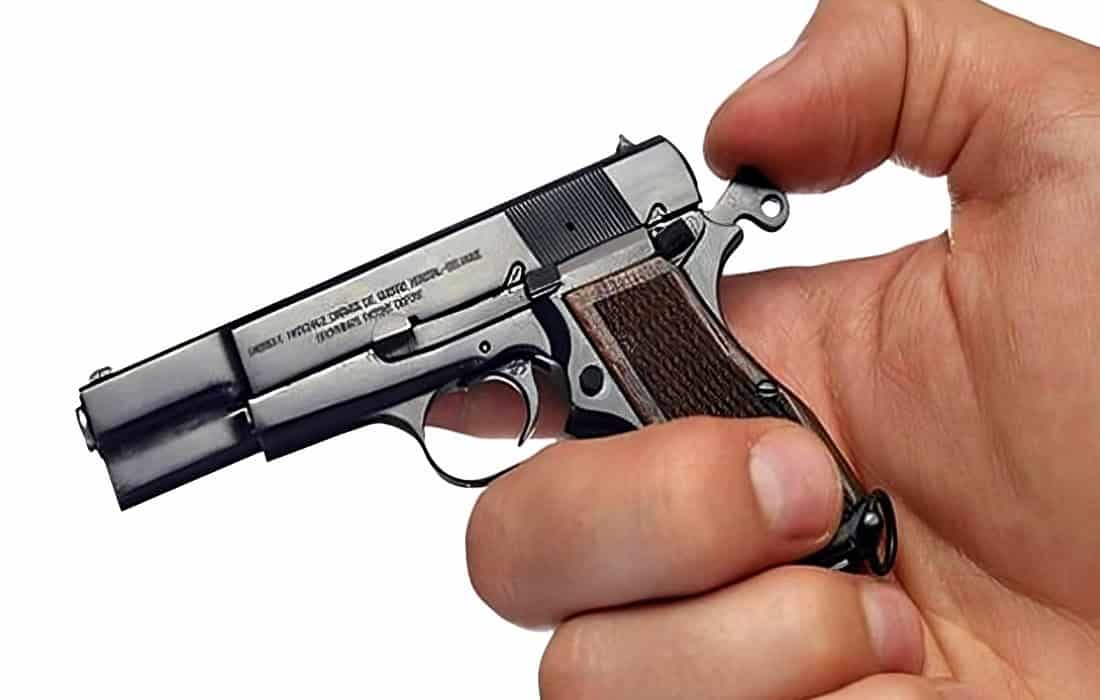
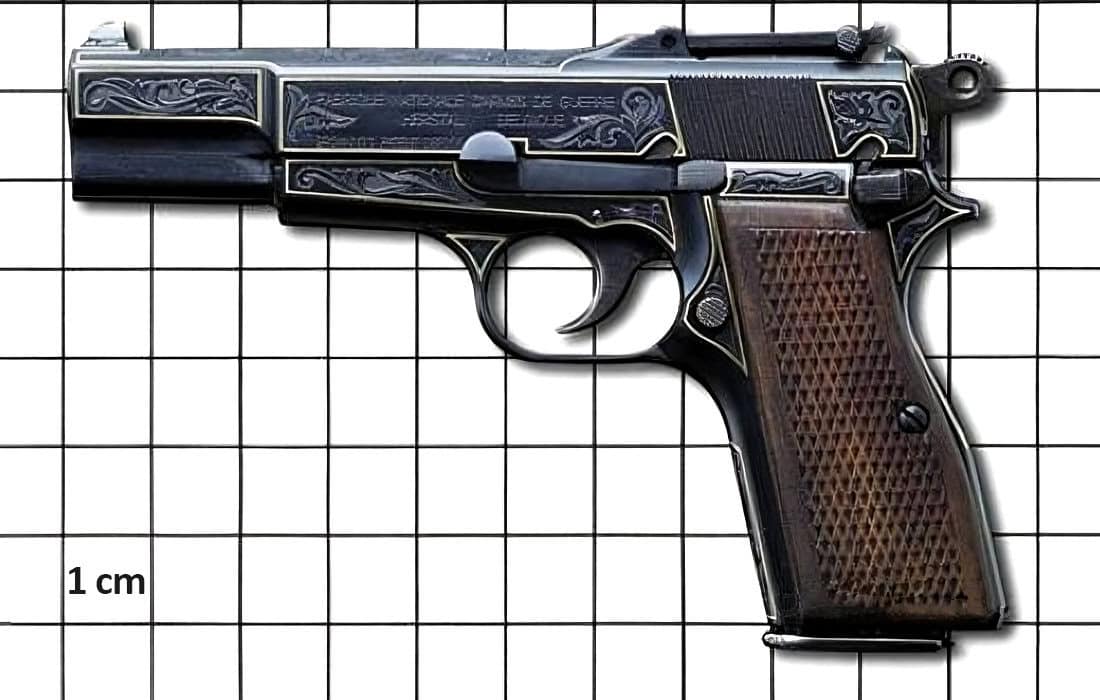
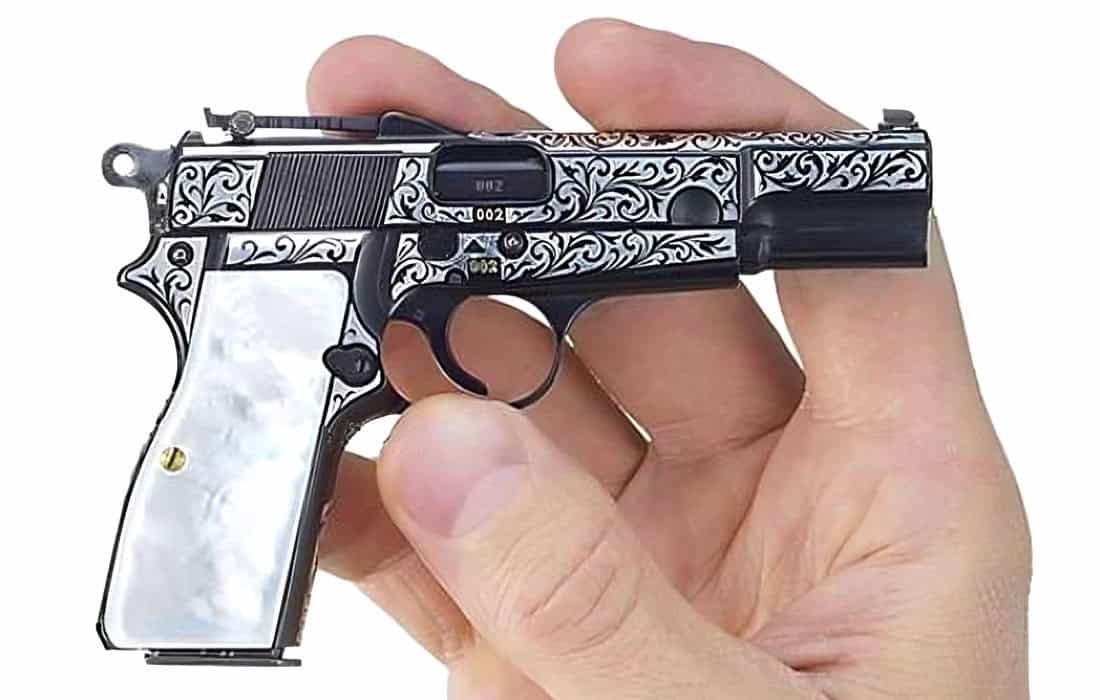
The cost of such a beautiful “toys” is about $15,000. Pretty expensive? Then we can offer you another version of a miniature Browning pistol that fires real cartridges. This model also perfectly combines authenticity and aesthetics, and it costs only $500. More details about it can be found here.
Browning Hi-Power (scale 1:3) Miniature Pistol
The miniature slide pistol Browning Hi-Power is a handcrafted, detailed, full-metal miniature gun with blueing, fine notched wood grips, and a neat engraving on the gun barrel. The model is equipped with moving parts like a movable shutter frame, a fuse, a hammer and a trigger, of course, and a magazine that can be removed and used as a place for cartridge storage. It’s an action scale model: the hammer is cocked, and when the trigger is pressed, a shot is fired.
About the Author
My name is Olha Polah, and I have been working in miniature weapons production since 2015. I started the mini firearms brand and have been running the brand’s Instagram page since 2016. The brand’s miniatures are popular worldwide, with fans in 25+ countries. I became the sole owner of the brand in 2018 and created a comprehensive line of miniatures. More than 60 models of miniature weapons from various historical periods have been created. In November 2023, I was interviewed by Robert Dunn for the GunTech magazine, where I talked about the hardships I had to endure in my business. I also run a newsletter for the brand’s customers, which has evolved into a full-fledged magazine with in-depth articles published on the wpolah.com.

My mission is to make people’s lives more joyful by sharing interesting facts about miniature weapons and inspiring everyone to express themselves.

